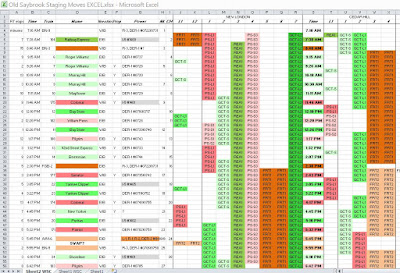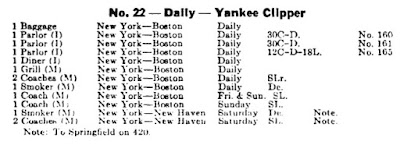What a fascinating - and frustrating - hobby this is! It offers an amazing amount of depth and breadth - everything from carpentry, electronics, art, scenery, architecture, historical research - but who has the time or money (or either!) to do any more than scratch the surface? The best model railroads balance all these wonderful aspects into a cohesive whole. And almost all model railroads risk teetering off that balance into a rabbit hole . . .
Ever since I decided to expand my erstwhile Valley Line to Old Saybrook, I was quickly swamped by the sheer amount of traffic on the New Haven RR's Shore Line - 71 trains every day! I (thought I) got around this a bit by being clever - reducing this schedule to just 4 mainline trains. But the prospect of capturing - even if only as sand through one's fingers - just a sense of the magnitude of this traffic and - better yet! - having it as such a dramatic contrast to the branchline operations, has proven much too much to resist.
Consequently, I've gone from "just" having the Saybrook Scene and "a few staging tracks at each end" to expanding & cramming as much staging as possible in what little space I have left in order to try and accommodate as many of the trains as I can. And even that's just barely adequate.
Friend Bill Chapin was no help at all a wizard when it came to figuring out that I COULD actually run ALL the trains that ran through Saybrook from 7:38am to 7:42pm. At least in theory.
Talk about an enabler. Here's the staging/choreography he came up with based on all the extensive prototype info I'd gathered:

|
You really should click on this to enlarge it. It's truly impressive. |
All the trains are color-coded and shown on the staging tracks where they originate and terminate. The colored times in the column between New London staging and Cedar Hill staging show what train is going through Old Saybrook at what time. Also indicated are the actual prototype times, train numbers, train names, and whether they stop at the Saybrook station. Following the track numbers downward, you see how long a particular staging track is occupied.
It all "works on paper" - last night I staged it, and a couple victims of us will try to operate it tonight.
Yeah, I'm a loooooong way away from the meandering, once-a-day Valley Local. At least for the moment.
And - believe it or not - this isn't even the squirrel distraction rabbit hole that prompted this post. One of the keys to what BillC did is that the passenger trains are "generic" and the consists are repeated.
For the most part. Unfortunately, I just can't leave well-enough alone. Yes, I confess, I've been delving into the railroad's Consist Books to determine what exactly was on each of the trains I plan to run. Case in point - here's the consist of The Yankee Clipper:

|
1942 Consist |

|
1950 Consist |
(Un?)Fortunately, I only have the consist books from 1942 and 1950. I model Autumn, 1947 (or 1948, or '49 - depending....) so I have plausible deniability regarding the "proper" consist. But look at the difference! In 1942, it was mostly heavyweight equipment, three Parlor Cars, and a few Osgood Bradley streamlined coaches. By 1950, there were only 2 parlors and most of the equipment was stainless steel coaches. And, as it happens, those stainless steel coaches were delivered in 1948.
So, what does the Yankee Clipper that runs through my model of Old Saybrook look like? Well, right now, it has "whatever I can get my hands on."
And, for the sake of my sanity (not to mention, my bank account), that might just have to do for now a while. In the meantime, at least that aspect of our broad-shouldered hobby called "historical research" costs me nothing. Just a lot of very enjoyable time . . .
Chris
http://www.thevalleylocal.net
Modeling the New Haven's Connecticut Valley Lines, c. Autumn 1947 (or 1948, or '49)
The Valley Local
Modeling the New Haven Railroad's Connecticut Valley Line, Autumn 1948